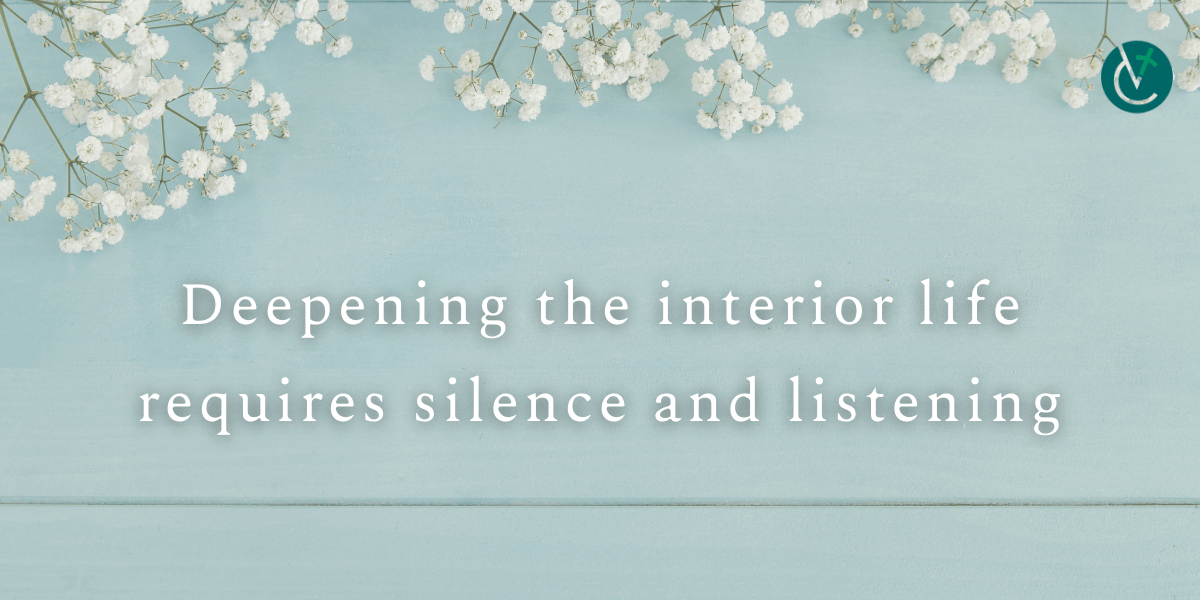
Deepening the interior life requires silence and listening
Every time my husband and I visit our young granddaughters in North Carolina, my husband takes them bike riding to the local park.
There is always lots of noise and instructions being proffered as Pop makes sure the girls are appropriately dressed, have their water bottles and their helmets and finally, their bikes.
One day, one of the girls surprised my husband on the driveway as she pulled along a bike with training wheels. “Why didn’t you tell me you couldn’t ride a two-wheeler?” my husband asked, realizing plans had to change to accommodate her slow pace.
She replied frankly, “I tried to, Poppy, but you wouldn’t stop talking.”
It was priceless.
It was also a statement of truth about the value of being silent long enough to listen.
There is power in silence. Rather than being a void that needs to be filled, it is the space between notes where the song breathes life. It is our opportunity to listen to the truth of others and the truth of God’s creation. It is the place within which we may encounter the whispers of God.
Among the saints, there is one who is known for his silence — St. Joseph, foster father of Jesus and husband of Mary. Scripture does not reveal one word St. Joseph spoke, yet his devoted presence in the life of the Holy Family is unmistakable.
Scripture relays that God speaks to Joseph in life-changing dreams that required difficult choices. Joseph doesn’t argue the point, ask for an explanation or offer alternative suggestions. His response is an interior one, a “yes” that leads to action and an understanding, on our part, of why God chose him as protector of the Holy Family.
Many popes have written and preached about St. Joseph, encouraging devotion to the humble man to whom was entrusted the care of God’s son. By listening to God and doing His will, Joseph ennobled the role of spouse, father and worker and serves as an example of faithfulness for the world.
In his apostolic letter, “Patris Corde” (“With a Father’s Heart”), announcing the Year of St. Joseph, Pope Francis reminds us of Jesus’ words, “’Learn from me, for I am gentle and lowly in heart.’ … The lives of the saints too are examples to be imitated. St. Paul explicitly says this: Be imitators of me!’ … By his eloquent silence, St. Joseph says the same.”
Mothers and fathers of the Church describe Joseph as a man with a profound interior life, one which can only be a result of embracing the silence that allowed him to know God’s will for him. It is likely these holy men and women share that he was influential in helping Jesus develop his own interior life.
Pope Emeritus Benedict XVI taught, “It is not exaggerated to say that Jesus will learn — on a human level — precisely from ‘father’ Joseph this intense interior life, which is the condition of authentic righteousness, the ‘interior righteousness,’ which one day he will teach to his disciples.”
We may not always think of ourselves this way, but we are those disciples. We need what Jesus sought to teach His disciples in real time, and what St. Joseph taught him — a deep interior life that grows in silence.
But how, in a world such as ours, filled with noise and endless distractions, can we deepen our interior lives? How can we engage in the spiritual conversation with the God that we know and feel is present in our lives and the God that we don’t understand? And where should those conversations lead us?
The first step is to decide it’s what we want. The rest will fall in place. Step by step, as we learn to quiet our thoughts, even brief moments of silence allow God the space to call our names and allow us to reply, “I am here.”
As we grow in this endeavor we may become, as Pope Francis described St. Joseph, a person “who knows how to accompany others in silence.”
Christianity, wrote Trappist monk Thomas Merton, “should make us more visibly human, passionately concerned with all the good that wants to grow in the world and that cannot grow without our concern.”
The rich inner life of a Christian can lead us there.
— Originally published in the Spring 2021 issue of Vermont Catholic magazine.

